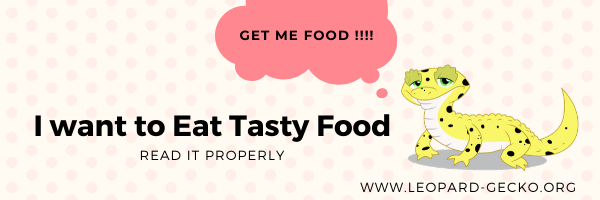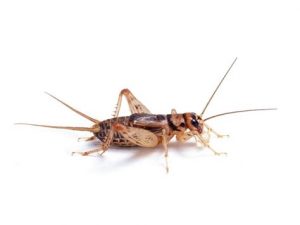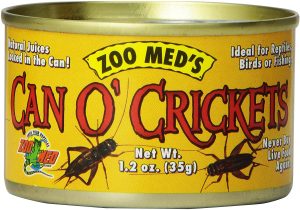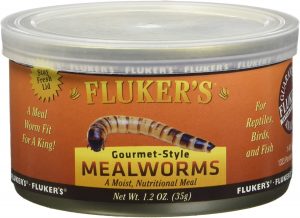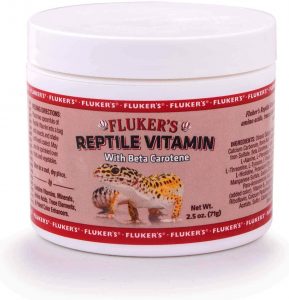Did you know, the Leopard geckos eat their shed skin and by eating the skin, they can use the nutrients to grow new skin.
So as an insectivorous reptile that primarily feeds on insects, what is the ideal leopard gecko food that you, as a keeper, should serve your Leo for a meal? With a variety of options and ideas available in the market, it can be quite intimidating to feed a reptile that likes to munch on its own skin.
Nevertheless, we have a step by step guide for you to follow and make sure that your pet gets the best leopard gecko food available in the market.
What is the best Leopard Gecko food?
Leopard geckos eat anything that wiggles or moves in front of them. In the wild, the leopard gecko can consume a variety of invertebrates, such as different species of spiders, beetles, locusts, caterpillars and occasionally smaller lizards or nesting rodents. Obviously, in the wild, there’s no guarantee that you’ll get food frequently, hence, geckos are extremely good at storing their food.
This is the reason why they have a chunky tail, unfortunately, this also means that they can easily get obese in captivity. In the wild, a healthy, non-breeding adult leopard gecko would consume around nine insects in a week.
Here’s a list of some of the best leopard gecko foods that are a blend of some popular insects which the keepers like to feed their leopard geckos with.
In a Hurry? Here’s Our Top Picks…
Best Leopard Gecko Food
Crickets
| Product Name | Product Preview | Check Price |
|---|---|---|
| Live Crickets (Medium) |
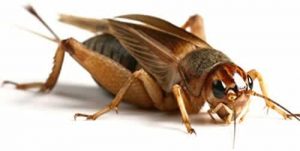
|
Check Price |
| Cricket Keeper (To store your live crickets!) |
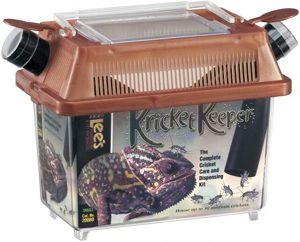
|
Check Price |
- Crickets are probably the most popular leopard gecko foods. They are healthy and are easy to purchase. When feeding crickets to your leopard gecko you should make sure that they are not too large in size as the larger ones are difficult to prey and digest.
- While choosing the size of your feeder insects, especially live banded crickets, we recommend you to select insects equal to or less than the distance between your animal’s eyes.
- It is always a good idea to leave a small piece of potato, carrot, or apple for the crickets to eat. The food will also draw out the crickets and make them easier to catch. However make sure you remove the crickets as well as the potato, carrots or any other food item if the gecko doesn’t eat it for more than 24 hours.
- Nutritional Information for leopard gecko food: Moisture 69.07%, Fat 6.01%, Protein 21.32%, Fiber 3.2%, Ash 2.17%, Ca ppm 345, P ppm 4238, CA/P ratio 0.081
- Easy to find, cheap, low fat, high protein, easy to care for, gut-loads well, the erratic movement stimulates feeding.
- Banded Crickets are the insect of choice for most lizards, amphibians, and other exotic pets like the leopard gecko. Josh’s Frogs 3/4″ Banded Feeder Crickets are of great size.
- Josh’s Frogs 3/4″ Banded Feeder Crickets are bred and raised to provide you with the best quality feeder insect. The crickets are fed vegetables and a specially formulated cricket food, that has been researched to provide the best results in nutrition, health, and longevity.
- This cricket also naturally contains more protein compared to other species of crickets, which is important for building and repairing tissue in your pets. Therefore adding this to your leopard gecko’s food chart is a win-win situation.
- They are also the cheapest crickets available online.
- Cricket breeding can be difficult, so make sure you check out Cricket Breeding Made Simple and do everything you can to feed your pet healthy, clean and virus-free food.
Mealworms
| Product Name | Product Preview | Check Price |
|---|---|---|
| Zoo Med Laboratories Can O Worms, 1.2oz Cans (3 Pack) |
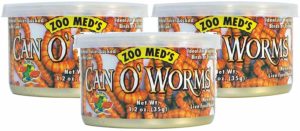
|
Check Price |
- Mealworm is a staple in the leopard gecko’s food chart. They are easy to get and are healthy. When feeding mealworms you should choose the ones that have freshly moulted so they are easier to digest.
- Feeding mealworms to a gecko is a simple task since they can be placed in a food bowl and are available whenever the gecko is hungry. The bowl must be smooth to prevent escape.
- Nutritional Information for leopard gecko food: Moisture 62.44%, Fat 12.72%, Protein 20.27%, Fiber 1.73%, Ash 1.57%, Ca ppm 133, P ppm 3345, CA/P ratio 0.040%
- Easy to find, cheap, high protein, easy to care for, a decent lifespan that can be prolonged by refrigeration, aren’t messy or smelly, easy to breed.
- These mealworms are bred and sold by Bassett’s Cricket Ranch in California. They will ship your worms in breathable cloth bags with 10 to 15% extra to cover any dead worms on arrival. They also guarantee live delivery year-around.
Waxworms
| Product Name | Product Preview | Check Price |
|---|---|---|
| 750-900 Live Waxworms (3 Cups of 200-300) - Best Bait for leopard Geckos |
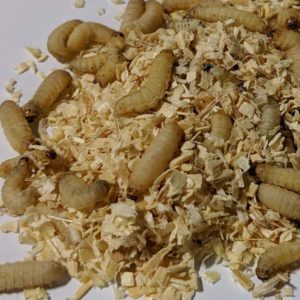
|
Check Price |
- Waxworms should only be fed to leopard geckos occasionally as treats (once or twice per week max) because they are high in fat and can become addictive to some geckos.
- Waxworms are the caterpillar of the wax moth, they are 0.75″ long and feed on the beeswax in honeycombs. Their high-fat content makes them a treat in the list of leopard gecko food, and even humans who practice eating insects love them! Fishermen know waxworms as ‘waxes’ and use them for catching panfish, rainbow trout, and salmon.
- Nutritional Information for leopard gecko food: Moisture 61.73%, Fat 22.19%, Protein 15.50%, Fiber 7.69%, Ash 1.02%, Ca ppm 283, P ppm 2161, CA/P ratio 0.131%
- Easy to find, cheap, irresistible to geckos, can be used to jump-start feeding.
- These wiggly and delicious worms come in a pack of 250 in Amazon. The Bassett’s Cricket Ranch wax worms are fat plump worms that can be an item of delicacy in your leopard gecko’s food menu.
Although, make sure that you avoid purchasing them during the summertime as you could be greeted by live moths coming out of cocoons.
Dubia Roaches
| Product Name | Product Preview | Check Price |
|---|---|---|
| Living Cricket & Dubia Roach Colony Starter Kit - Includes 8 Egg Flats, Premium Dubia Roach Chow Cricket Food (1 lb), 2 Water Gel Granules (1 oz) | Raise Dubia Roaches Crickets |
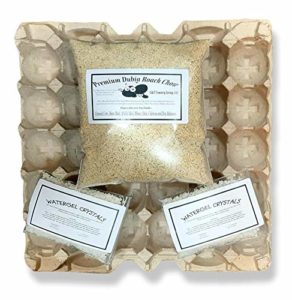
|
Check Price |
- Dubia roaches are healthy and tasty for leopard gecko’s food. They are also very easy to breed and many owners will create their own Dubia roach colony to save money.
- They can’t fly, climb smooth surfaces, or make any annoying noises. They also have more protein than any other insect used as a leopard gecko food.
- Nutritional Information for leopard gecko food: Moisture 65.6%, Fat 7.2%, Protein 23.4%, Fiber 2.9%, Ash 1.2%, Ca ppm 800, P ppm 2600, CA/P ratio 0.308%
- High protein, low fat, easy to care for, extremely long lifespan as a nymph to adult can live up to 2 years, gut-loads very well, no smell, high calcium to phosphorous ratio, easy to breed your own feeder colony, the movement stimulates feeding.
These roaches add to your leopard gecko’s food list perfectly. You can purchase this leopard gecko’s food from Amazon for as much as $10 for 50 live 3/8” roaches.
Superworms for Leopard Gecko
| Product Name | Product Preview | Check Price |
|---|---|---|
| Superworms Large Live 500 Reptile, |
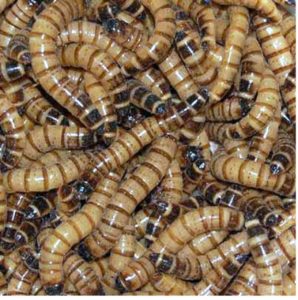
|
Check Price |
- A superworm is around times larger than a mealworm in girth and length. Most of the size difference comes from a superworm having more chitin, their shell than mealworms do. This gives them less meat, but a higher concentration of calcium, fibre, and fat.
- Nutritional Information for leopard gecko food: Moisture 59.37%, Fat 17.89%, Protein 17.41%, Fiber 6.80%, Ash 1.20%, Ca ppm 124, P ppm 2320, CA/P ratio 0.053%.
- Easy to find, cheap, decent protein, easy to care for, long lifespan (no refrigeration needed), easy to care for, no mess or smell, easy to breed your own feeder colony.
This pack of 500 worms that will last you up to two months is by the brand called Bassett’s Cricket Ranch. They are known for their excellent delivery and quality of live insects. You’ll receive well-nourished and healthy 500 superworms will a very less chance of even a single one being dead.
Phoenix Worms (Black Soldier Fly Larvae)
| Product Name | Product Preview | Check Price |
|---|---|---|
| Phoenix Worms 100 Large Original BSF Black Soldier Fly |
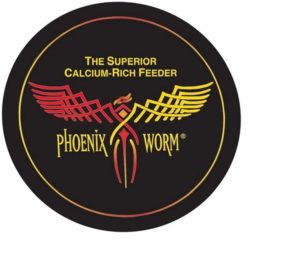
|
Check Price |
- Nutritional Information for leopard gecko food: Moisture 61.2%, Fat 9.4%, Protein 17.3%, Ca ppm 8155, P ppm 5355, CA/P ratio 1.52%.
- Low fat, easy to find, cheap, best calcium to phosphorous ratio feeder available, decent protein, decent shelf-life (3 weeks), the movement stimulates feeding.
MEAL REPLACEMENT POWDER FOR LEOPARD GECKO’S FOOD
- The meal replacement powder is an alternative source of leopard gecko food for the juvenile geckos. Although geckos are insectivores and don’t feed on fruits or vegetables, the baby geckos relish this as leopard gecko food.
- Mix one part of meal replacement powder with two parts of water by volume as a starting point. The mixture may appear watery at first but will thicken after several minutes. If separation occurs over time, use less water. As fed, meal replacement powder should have the consistency of ketchup. Feed geckos in the evening and remove uneaten meal replacement powder within 24 hours.
- Nutritional Information for leopard gecko food: Crude Protein min. 25%, Crude Fat min. 7%, Crude Fiber max. 8%, Moisture max. 8%, Ash max. 8%, Calcium min. 1.2%.
Ca ppm = Calcium Parts Per Million
P ppm = Phosphorous Parts Per Million
CA/P ratio = Calcium to Phosphorous Ratio
LEOPARD GECKO FOOD – HOW SHOULD I TAKE CARE OF THE INSECTS TO BE FED?
Once you have the basic knowledge of the variety of insects you can add to your leopard gecko’s food, you will then need to shift your focus on taking care of these insects. A healthy insect will serve as healthy food to your leopard gecko.
- Your leopard gecko will need vitamins and minerals to remain healthy and the best way to ensure your gecko gets enough vitamins and minerals is by gut loading and dusting the insects you’re feeding it.
What is gut loading?
GUT LOADING is the process of feeding the bugs and worms with nutritious food before you serve them as leopard gecko food. It is recommended to gut load your insects 12 hours prior to feeding them to your leopard gecko. This way the insect will still have the nutritious food in their body and will be ready to serve as leopard gecko’s food. There are much cricket feeds available that are perfect for gut loading.
The Fluker’s High-Calcium Cricket Diet
- You can use this food in conjunction with the Flukers cricket quencher and it will keep your feeder crickets healthy for a sumptuous leopard gecko’s food. Crickets seem to love this formula and it is pretty entertaining to watch them flock around it. This set up saves a ton of money as you can purchase crickets online in bulk instead of paying high pet store prices. This product makes gut loading super easy and you don’t have to worry about rotting and moulding.
- These diets are generally easier to feed than those you come up with yourself, and they will gut load your crickets with all of the vitamins, minerals, proteins, carbohydrates, and fats that they need to provide your reptile with an excellent source of nutrition. You can supplement their diet with pieces of vegetables such as fresh lettuce and orange slices for added moisture and nourishment.
Nature Zone Cricket Total Bites Soft Moist Food
- This 1-gallon bucket is a natural source of more than 15 nutrients, vitamins, and minerals. It works as a water and nutrient source and even herps can digest it so you don’t have to worry that there might be problems if your animals eat it for leopard gecko’s food. You can leave pieces of this around the cage so the crickets can Gut load while your gecko gets around to eating them.
- It comes in big cubes so it won’t dry out as quickly and it makes it easier to feed dubias or crickets instead of dumping a bunch of tiny cubes on everything.
Nature Zone Total Bites for Crickets & Feeder Insects
- This one for the keepers that prefer ready to go cubes and don’t have the time and patience to cut separate cubes from one giant block. Ready to eat food designed specifically to feed, water and gut-load feeder & pet insects in one easy step. It comprises quality proteins, carbohydrates, vitamins, & minerals deliver complete nutrition that is easily digestible by both insects and herps.
- Recommended For: Crickets, Mealworms, Super Worms and Dubia Roaches. Also great for pet Roaches, Tarantulas, other insects, arachnids, and isopods.
- If you’re using mealworms as leopard geckos food you should gut load them with carrots 24 hours before feeding. You can also place some of the cricket gut loading food into the dish containing the mealworms so they will eat some of that too. Some owners that leave mealworms in their leopard gecko’s tank all day will leave food in the dish for the mealworms to eat. This way the mealworm is gut-loaded whenever you want to serve them as leopard gecko’s food.
HOW SHOULD I GUT LOAD THE FEEDER INSECTS?
- You should always gut-load your feeder insects 24 hours before serving them as leopard gecko’s food. However, some feeder insects cannot be gut-loaded, like the phoenix worms should not be gut-loaded because they will foul the medium and allow bacteria & fungal growth. Make sure you study about your feeder insects before gut-loading them.
- Some feeder insects gut-load better due to their large digestive tracts, feeders such as crickets and dubia roaches are great at gut-loading. Other feeder insects such as mealworms & super worms are not so good at gut-loading due to smaller digestive tracts. Gut-loading your feeders will ensure they are full of moisture and nutrients when you serve them as leopard gecko food.
- It is important to note that leopard geckos get a majority of their moisture needs through the leopard gecko food they eat. While they do drink water, water is scarce in their natural wild habitat. They have evolved to adapt to the dry arid environment by absorbing moisture from the insect feeders they eat. Also, they do not urinate, they pass rates to conserve loss of water in their bodies. This is why gut-loading is important.
- Carrots, leafy greens, fruits, and oats/bran are all good perfect for gut-loading.
What is dusting?
Dusting is the process where you purchase a dusting powder (such as a calcium and vitamin D3 supplement) and dust the feeder insects in the powder before your leopard gecko eats them. Most owners will dust their insects by placing the insects and a small amount of dusting powder in a glass jar and gently shaking it until the bugs are lightly coated with the powder. After you dust the insects you should immediately feed them to your Leo, otherwise, the feeder insects may clean the powder off themselves.
Now, the most frequently asked question is, What and why should I dust vitamins on my insects?
- You see Vit. D3 does not appear in sufficient amounts naturally in feeder insects. The ideal calcium to the phosphorous ratio for leopard gecko is 2:1 and none of the feeder insects hit the perfect 2:1 ratio.
- For diurnal species such as iguanas and bearded dragons, they can bask under UV and synthesize vitamin D3 from UVB. Since leopard geckos are crepuscular, they get very limited exposure to UV even in nature. Vitamin D3 is required for proper absorption of calcium. It is important to always dust your feeder insects with a good multivitamin supplement prior to feeding them to your geckos.
- The Zoo med repetitive with D3 is an all-in-one calcium powder with added vitamins, trace minerals, and carotenoids for dusting feeder insects. It contains a 2:1 calcium to phosphorous ratio and has vitamin D3. It is an all-in-one so no further supplement is needed when you dust your feeders with these products. We have used this commercial multivitamin extensively for over 5 years and it has worked very well for us.
HOW SHOULD I DUST MY FEEDERS FOR THE LEOPARD GECKO FOOD?
- You should dust your feeders before every time you serve them as leopard gecko’s food. For young/juvenile leopard geckos, you would usually feed every day or every other day. You should dust your insects each time you feed. As your gecko’s age, once they reach adulthood (12 months old+), they’re more likely to eat less, maybe every 3-4 days. You would still dust the insects every 3-4 days as you feed them.
- The most popular method is the shake-n-bake. You take a plastic sandwich bag, drop some feeders in it, dust the feeders with your multivitamins, and shake them up.
- Make sure you serve them as leopard gecko’s food right after you’ve dusted the insects, otherwise the insects will clean the powder off themselves.
- One of the common things gecko hobbyists used to do was to leave a bottle cap full of pure calcium, phosphorous free, inside the tank at all time. This was back in the days before all-in-one supplements became popular. Now, supplements like the Zoo Med Reptivite with D3, you don’t need to leave calcium inside the tank anymore.
- Although some keepers still prefer keeping calcium and phosphorous inside the tank. When leaving leopard gecko calcium inside the tank for free-feeding, it’s important to only use pure calcium, phosphorous-free, without vitamin D3. This is because too much vitamin D3 can be toxic for your leopard gecko. You can’t control how much they eat when you leave calcium in the tank, that’s why you should only use the formula without vitamin D3. Zoo Med Repti Calcium without D3 works perfectly for this purpose.
- Another important point to be noted is that once you break the seal of a bottle of vitamins, the potency of the vitamins will degrade over the period of time. There are gecko hobbyists that don’t realize that there is an expiration date on their bottle of gecko vitamins. For optimal vitamin potency and stability, you should use up your multivitamin within 1 year of opening the seal. Also, you also shouldn’t buy a bottle of vitamins if it’s near or after the expiration date.
HOW OFTEN SHOULD YOU SERVE THE LEOPARD GECKO FOOD?
- Feeding your pet with the leopard gecko food depends upon a lot of factors. If its younger than a year, it should be fed every day.
- The healthy ones that have started to develop a chunky tail should be served with leopard gecko food every other day. A chunky tail means it is storing the excess fat in its tail. In this case, you should reduce the amount or frequency of serving the leopard gecko food.
- The sick ones should be fed once a day until they regain their health.
- Leopard gecko’s food should be given late in the day or early in the evening, as that is the time they are likely to start hunting in the wild.
- If your gecko is a problem eater, feed it normally, but leave a dish with worms in its tank in case it wants to eat later.
- You should tailor the amount the leopard gecko food you give your Leo and according to their eating habits and activity levels.
WHAT PORTIONS OF LEOPARD GECKO FOOD SHOULD YOU FEED YOUR PET?
- As a rule, you shouldn’t feed your gecko insects bigger than the space between his eyes.
- The baby geckos should be served with leopard gecko food such as crickets that are around 3/8 inches in size.
- The juvenile ones should be given the leopard gecko’s food with crickets that are around 1/4 inch in size.
- Adult geckos should be fed with a small adult to adult size crickets.
- Baby Geckos: You should feed your baby gecko crickets that are around 3/8 inches in size.
- Juvenile Geckos: You should feed your juvenile gecko crickets that are around 1/4 inch in size.
- You only want to give the gecko as many insects as it will eat in 15 to 20 minutes. You do not want a bunch of insects living in the cage, not getting eaten. This can cause disease and dirtiness to build up in the cage.
HOW SHOULD I CHOOSE THE FEEDER INSECTS AS THE BEST LEOPARD GECKO FOOD?
- While opting for what feeder insects to use as leopard gecko’s food, variety is the key. All the feeder insects vary in nutritional value as some contain more fat, others contain more protein and while most feeder insects lack in calcium to phosphorous ratio, Phoenix Worms remain an exception. We recommend adding variety to your leopard gecko’s food list so they can have a balanced diet.
- For example, if you include a staple diet of super worms to your leopard gecko’s food list, your gecko will become obese within no amount of time. Superworms are high in fat and contain below-average protein. Every other week you can switch it up by introducing crickets (low in fat, high in protein), then another couple of weeks you can introduce some phoenix worms (low in fat, average protein, high in calcium/phosphorous ratio) to your leopard gecko’s food. This variety and change in leopard gecko’s food will give you it a much more balanced diet.
- Even if you choose to include high nutritional value feeders into your leopard gecko’s food list, such as dubia roaches, which are low in fat and high in protein, you should still introduce a variety. We recommend adding Phoenix Worms to the mix of leopard gecko’s food for added calcium and taste value. We call it to taste values because leopard geckos tend to love these soft yummy treats. Plus the way they move around stimulates gecko’s feeding.
CAN FRUITS AND VEGETABLES BE SERVED AS LEOPARD GECKO’S FOOD?
Here’s the answer, NO! and allow me to explain why?
- Leopard geckos are insectivores and in a broader term, they are carnivorous animals. You see there’s a difference between a carnivore (animals that feed on other animals) and a herbivore (an animal that feeds on plants) and it is much more than just their taste preferences.
- Animals with a plant-based diet (herbivores) can digest cellulose. Cellulose stiffens plant wall cells, so if the animal can’t digest that, it can’t eat a plant-based diet. Therefore, to digest a plant-based diet, a carnivore will need to have all the bacteria and micro-organisms to help break it down. These bacteria and micro-organisms are found in the Cecum which is situated in the large intestine. It works like a little chamber that ferments all the plant matter that can be digested. In carnivores, Cecum has no function, unlike the herbivores and omnivores.
- A carnivore has a short, simple and smooth alkaline colon, while a herbivore has a long, complex, acidic colon. Carnivores can digest their food in 2-4 hours, while herbivores can take up to a day.
- Carnivores can detoxify Vit. A while grass eaters can’t.
- So, as you can see, there are many reasons why including lettuce, carrots, and other plant-based food in your list of leopard gecko food is not sensible. We would, therefore, recommend sticking to an insect diet for your leopard gecko’s food that can be naturally digested.
LEOPARD GECKO FOOD AND OBESITY
- It is the responsibility of the keeper to avoid overfeeding their Gecko, to help prevent obesity.
- In its natural habitat (the dry regions of South-eastern Asia), the availability of food varies drastically according to conditions.
- For this reason, Leopard Geckos have developed a habit of effectively processing and storing food, which is helpful in the desert but may cause over-eating and obesity in captivity.
- As they carry their fat in their tails, it is not always obvious they are gaining too much weight, but this can still have health consequences.
- As a rule, a gecko’s tail must always be wider than its body and its stomach should be mostly flat (except for right after feeding).
- Overfeeding it can cause it to regurgitate its food and may cause lethargy. If you notice any of these issues with your pet, you should cut back on the amount of food you feed it and make sure not to feed it fatty insects (like Waxworms and Butterworms).
- Always remember to never include waxworms as a staple in leopard gecko’s food.
WHAT SHOULDN’T BE INCLUDED IN THE LEOPARD GECKO FOOD?
- Bugs that light up are toxic and shouldn’t be included in the list of leopard gecko’s food. The most harmful insects are bugs that light up (like Lightning Bugs and Fireflies).
- These bugs contain chemicals which are extremely toxic to geckos and should never be used as leopard gecko’s food.
- Wild-caught insects can be toxic to Leopard Geckos although people vary with their opinions on whether to feed the geckos insects you’ve caught yourself or not.
- Some websites say that these can be a good (and cost-effective) source of nutrition in the list of your leopard gecko’s food items, while others say you should never feed wild caught insects to your gecko, as these may contain parasites or have traces of pesticide that can be toxic.
- If you do choose to feed your gecko insects you’ve caught yourself, make sure you have an in-depth knowledge on the kind of insects which are toxic to geckos and be aware of pesticide contamination (so, preferably stick to your own garden).
- Keep these as a treat to stop your gecko from becoming addicted to them and refusing to eat shop-bought food.
- HOW TO BREED FEEDER INSECTS FOR LEOPARD GECKO’S FOOD?
- Are you considering raising multiple types of feeders? If your answer is yes, then there are a few things you need to think about before trying to make sure you can provide all that the feeders need.
- Space is incredibly important, certain species will not only need different types of cages but different sizes as well. You will need larger enclosures to breed certain insects like crickets don’t do well long-term in smaller enclosures not only because of gas buildup but also because of territorialism between them and the possibility of cannibalism happening. Dubia roach males are also highly territorial and need their space to safely claim at least one side of an egg crate as their own or they will start damaging the other males and females occasionally.
- The cost of breeding these insects can be something that should be taken into consideration. But there are a lot of cost-efficient products and substitutes that can be installed. Saving up egg crates is always useful. You can ask family members or friends to do the same and only buy cardboard or you can ask grocery stores or restaurants whether they can provide some if you are running low. eBay is always a possibility too. You can use fruits and veggies that are just a bit too far gone but not mouldy or scraps from the night’s dinner. You can either make dry chow yourself from bulk ingredients in grocery stores or you can look for a good chow that’s premade. If you want to keep species that are illegal in certain countries like dubia roaches in Florida, you need to look into getting permits or licenses to do so. They aren’t cheap and you should only do it if you are serious. Saving money on electricity can always be done by installing solar panels.
- Time is another factor. You’ll require somewhere between a couple of hours to even more depending upon the number of feeders you’re breeding.
- On the other hand, having your own feeder colony will reduce your feeder expenses in the long run. If you own many geckos, not just leopard geckos, but perhaps different species of reptiles. Often these feeders are suitable to be fed to most if not all of them. Dubia roaches are easy to breed and some breeders even sell dubia roaches breeding colony with a male and a handful of female roaches.
- For mealworms and super worms, you’d want to use wheat bran as the bedding. Start by placing them in a shoebox and gut loading them by using carrots and green vegetables 24 hours prior to serving them as leopard gecko’s food.
- Mealworms can be refrigerated to prolong their life. Refrigeration slows down the pupating process of the mealworms.
- Superworms, however, should not be kept inside the refrigerator as they will die.
- Phoenix worms should be kept in the bedding they come in. They should not be fed or gut-loaded or they will foul the bedding medium, causing mould & bacterial growth.
- Crickets should be kept in a cricket keeping container, or a very tall Sterilite storage box. Egg flats should be placed inside to give crickets more room. There are specially formulated cricket gut-load diet which is high-calcium cricket diets. They will work well for feeding your crickets. You will also need to provide a water source for your crickets. If you use plain water, it can get messy. The cricket container will get wet, and you will likely have mould growth and cricket deaths as a result.
- Waxworms should be kept in the same bedding/container they get shipped in. They cannot be fed or gut-loaded. Keep them dry and don’t place them near a warm/humid spot, or they will die off really fast.
- Avoid catching wild insects and serving them leopard gecko food.
- Insects in the wild can carry diseases and parasites. They often come with pesticides since they feed on greens in the wild. Bottom line is you never know what wild insects carry, so you should never catch wild insects and feed them as leopard gecko’s food. You would, therefore, want to add the only captive-bred feeder insects to leopard gecko’s food list.
WHAT SHOULD A LEOPARD GECKO DRINK?
- Your Leopard Gecko must drink clean, freshwater, that should be available in your gecko’s tank at all times.
- Make sure the dish is shallow so that your gecko can drink from it easily, and there is no chance of it drowning if in case it falls into it.
- As the substrate in the cage should be kept dry, the dish should be stable to avoid spillage.
